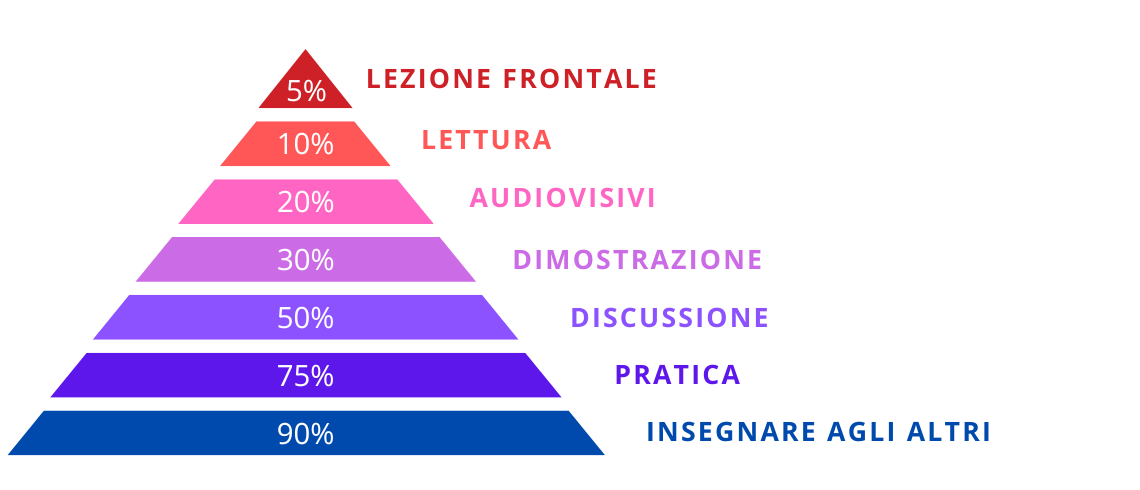
Learning Pyramid: what it is and how it works

Which learning modes are most effective in terms of knowledge retention?
The Learning Pyramid is a theoretical model that identifies different modes of learning and measures their effectiveness in terms of retention of learned knowledge.
This model is visually represented as a pyramid: active forms of learning (learning by doing, group work, etc.), which are attributed with higher effectiveness, form the base of the pyramid, while passive forms of learning (lecture, reading, etc.), which are attributed with lower effectiveness, form the tip.

The 7 elements of the Learning Pyramid
The learning pyramid is divided into 7 sections corresponding to 7 different modes of learning, which are assigned percentages of effectiveness in terms of an individual's retention of learned knowledge.
1. Frontal lecture (5%)
According to the learning pyramid, the classic frontal lecture represents the most passive form of learning in that the student receives information from a lecturer without the need to show any understanding or application of knowledge. However, it is the most effective way to quickly provide a lot of information to students.
Overall, frontal lecture is attributed a 5% effectiveness in terms of knowledge retention. It goes without saying that this may vary from person to person. Auditory learners, in fact, are better at learning through a frontal lecture than visual or kinaesthetic learners.
For more information, also read, " Learning styles: how do your students learn?"
2. Reading (10%)
Compared to listening to a lecture, reading is considered slightly more effective for memorizing learned concepts. It, in fact, adds a visual element that listening to a lecture does not offer and provides students with reference materials to which they can return later to retrieve information.
Overall, however, reading is also a passive learning method that is considered ineffective.
3. Audiovisual (20%)
Although considered a form of passive learning, training through audiovisual media is considered more effective than the previous training methods because it incorporates other elements of learning. Most often it is still a lecture, but it uses visual tools (pictures, handouts, flipcharts, presentations, projections, and videos) that enhance learning retention.
According to the pyramid theory of learning, students retain about 20 percent of the information they receive through these tools, which are therefore more effective than the previous two learning methods.
4. Demonstration (30%)
Learning by demonstration involves watching a teacher show students how to do something by guiding them through a step-by-step process. While the teacher shows how to do the task, he simultaneously explains to students what they are doing.
According to the Learning Pyramid classification, demonstration is the first learning method considered "active." Because demonstration often provides information more clearly than passive study methods, it leads to greater understanding, especially when information is vague or confusing, and greater assimilation of knowledge (30 percent).
5. Discussion (50%)
Discussions promote the creation of an active and cooperative learning environment that leads to greater retention of information (50%).
Those who participate in a discussion actually offer a variety of viewpoints, respond to the ideas of others, and engage in self-reflection to deepen their understanding or interpretation of a given topic. This fosters a collaborative and open exchange of ideas that requires understanding and reflection on information, promoting retention of learned knowledge.
6. Practice (75%)
Practical application is considered one of the most effective learning methods because it allows an individual to apply what he or she has learned to everyday practice, fostering deeper understanding and long-term retention of the information learned (75%).
In this area, technology has significantly amplified opportunities for practice through simulation, thanks to tools such as augmented or virtual reality.
Simulated learning allows people to safely manipulate systems and thus observe the impact of change, receiving immediate intrinsic feedback.
7. Teaching others (90%)
According to the Pyramid of Learning, this is the most effective method for memorization and retention of knowledge (90%).
In order to impart knowledge to others, an individual must in fact have a thorough understanding of the concepts and details around a topic. It is also believed that the act of interacting with students and answering questions deepens an individual's critical thinking and enhances knowledge retention.
Translated with www.DeepL.com/Translator
Did you like this article? Sign up for the newsletter and receive weekly news!
Subscribe to NewsletterComments:
No comments are in yet. You be the first to comment on this article!